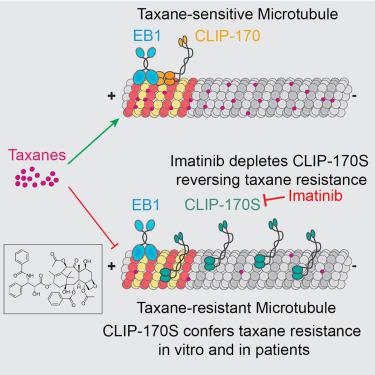Developmental Cell ( IF 10.7 ) Pub Date : 2021-10-20 , DOI: 10.1016/j.devcel.2021.09.023 Prashant V Thakkar 1 , Katsuhiro Kita 1 , Urko Del Castillo 1 , Giuseppe Galletti 1 , Neel Madhukar 1 , Elena Vila Navarro 1 , Isabel Barasoain 2 , Holly V Goodson 3 , Dan Sackett 4 , José Fernando Díaz 2 , Yao Lu 5 , Arindam RoyChoudhury 6 , Henrik Molina 7 , Olivier Elemento 1 , Manish A Shah 1 , Paraskevi Giannakakou 1

|
Taxanes are widely used cancer chemotherapeutics. However, intrinsic resistance limits their efficacy without any actionable resistance mechanism. We have discovered a microtubule (MT) plus-end-binding CLIP-170 protein variant, hereafter CLIP-170S, which we found enriched in taxane-resistant cell lines and patient samples. CLIP-170S lacks the first Cap-Gly motif, forms longer comets, and impairs taxane access to its MT luminal binding site. CLIP-170S knockdown reversed taxane resistance in cells and xenografts, whereas its re-expression led to resistance, suggesting causation. Using a computational approach in conjunction with the connectivity map, we unexpectedly discovered that Imatinib was predicted to reverse CLIP-170S-mediated taxane resistance. Indeed, Imatinib treatment selectively depleted CLIP-170S, thus completely reversing taxane resistance. Other RTK inhibitors also depleted CLIP-170S, suggesting a class effect. Herein, we identify CLIP-170S as a clinically prevalent variant that confers taxane resistance, whereas the discovery of Imatinib as a CLIP-170S inhibitor provides novel therapeutic opportunities for future trials.
中文翻译:

CLIP-170S 是一种微管 +TIP 变体,通过削弱药物与靶标的结合来赋予对紫杉烷类的抗性
紫杉烷类是广泛使用的癌症化疗药物。然而,在没有任何可操作的抗性机制的情况下,内在抗性限制了它们的功效。我们发现了一种微管 (MT) plus-end-binding CLIP-170 蛋白变体,以下称为 CLIP-170S,我们发现它富含紫杉烷抗性细胞系和患者样本。CLIP-170S 缺少第一个 Cap-Gly 基序,形成更长的彗星,并阻碍紫杉烷进入其 MT 腔结合位点。CLIP-170S 敲低逆转了细胞和异种移植物中的紫杉烷抗性,而它的重新表达导致了抗性,这表明了因果关系。使用与连接图结合的计算方法,我们意外地发现伊马替尼预计会逆转 CLIP-170S 介导的紫杉烷耐药性。事实上,伊马替尼治疗选择性地耗尽了 CLIP-170S,从而完全逆转紫杉烷抗性。其他 RTK 抑制剂也耗尽了 CLIP-170S,表明存在类别效应。在这里,我们将 CLIP-170S 确定为一种临床上普遍存在的变异体,它赋予紫杉烷抗性,而伊马替尼作为 CLIP-170S 抑制剂的发现为未来的试验提供了新的治疗机会。











































 京公网安备 11010802027423号
京公网安备 11010802027423号